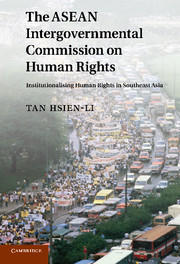 The ASEAN Intergovernmental Commission on Human Rights
The ASEAN Intergovernmental Commission on Human Rights Book contents
- Frontmatter
- Contents
- List of tables
- Preface
- 1 Charting the human rights institutionalisation process in Southeast Asia
- 2 Enough of ‘Asian values’: roots of the ASEAN states' reticence towards human rights
- 3 Self-determination and democracy: the human rights experiences of five ASEAN states
- 4 Instituting the regional rights regime: the ASEAN Intergovernmental Commission on Human Rights (AICHR) and the role of civil society
- 5 Human rights understanding between the ASEAN region and the United Nations: convergence, regional cohesion, and national responsibility
- 6 The unexplored aspect of human rights: what ASEAN needs to understand about the right to development
- 7 Sustaining AICHR's substantive empowerment: implementation, integration, and international law
- Bibliography and sources
- Index
5 - Human rights understanding between the ASEAN region and the United Nations: convergence, regional cohesion, and national responsibility
Published online by Cambridge University Press: 07 September 2011
- Frontmatter
- Contents
- List of tables
- Preface
- 1 Charting the human rights institutionalisation process in Southeast Asia
- 2 Enough of ‘Asian values’: roots of the ASEAN states' reticence towards human rights
- 3 Self-determination and democracy: the human rights experiences of five ASEAN states
- 4 Instituting the regional rights regime: the ASEAN Intergovernmental Commission on Human Rights (AICHR) and the role of civil society
- 5 Human rights understanding between the ASEAN region and the United Nations: convergence, regional cohesion, and national responsibility
- 6 The unexplored aspect of human rights: what ASEAN needs to understand about the right to development
- 7 Sustaining AICHR's substantive empowerment: implementation, integration, and international law
- Bibliography and sources
- Index
Summary
Introduction
In the previous two chapters, we saw that the thawing attitude towards human rights in the Association of Southeast Asian Nations (ASEAN) was gained through persistent persuasion by the Working Group for an ASEAN Human Rights Mechanism (‘Working Group’). Other important factors like the growth of a more vibrant civil society as well as the widening of public awareness also provided the concomitant impetus for states to realise that necessary space within society must be given to political, media, and information freedom over and above the emphasis on socio-economic rights. Even as ASEAN becomes more accepting of human rights, building the ASEAN Intergovernmental Commission on Human Rights (AICHR) into a fully fledged regional mechanism is yet to be fully welcomed by its member states. To improve this situation, United Nations (UN) support would be very valuable.
While the process to establish a human rights mechanism moved at the ASEAN level from the 1990s, another phenomenon at the international level was observed. In this chapter, we discover that, although AICHR for the time being does not meet international thresholds for promoting and protecting human rights, the gap has closed considerably between ASEAN human rights milestones and the programmes initiated by the UN Regional Arrangements for the Promotion and Protection of Human Rights in the Asian and Pacific Region (‘UN Regional Arrangements for the Asia-Pacific’).
- Type
- Chapter
- Information
- The ASEAN Intergovernmental Commission on Human RightsInstitutionalising Human Rights in Southeast Asia, pp. 181 - 205Publisher: Cambridge University PressPrint publication year: 2011


